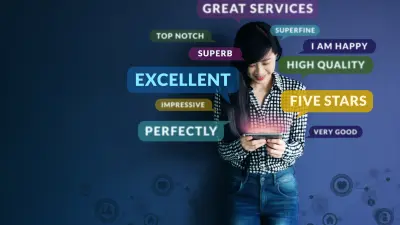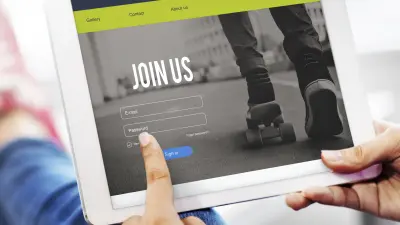
Get personalized content recommendations and answers drawn from our website. Simply type your question or topic of interest, and our AI assistant will help you find relevant articles, tips, and insights. You can also have a natural conversation to explore topics in more depth.
What is a Landing Page?
You’ve probably heard of landing pages before if you working on lead generation or increasing traffic to your website. But exactly what is a landing page, why you should have one (or even several), and how does a landing page work?
Many business owners think that the homepage is the be-all and end-all page of their website. This is partially true, but you’re missing some great opportunities if you don’t have landing pages factored into your online marketing strategy.
If you want to get prospective customers to your site, you need to have a place to send them that is also specific to your campaign or goal.
A landing page gets its name because it is a web page where your target audience will “land” when they perform a particular search query and click on the result in the Google SERP. They are also sometimes referred to as lead capture pages, squeeze pages, opt-in pages, destination pages, or even sales pages.
Types of Landing Pages
There are two types of landing pages: lead generation landing pages and sales landing pages.
Lead generation landing pages are designed to capture the visitor’s contact information and get them on an email list. A simple squeeze page typically will only collect name and email, but depending on your goal, you may want to capture phone number and other in-depth details about a person or their needs. But what all lead generation opt-ins have in common is that they present some type of compelling offer such as a free ebook, trial, webinar, video series, etc. to entice visitors to sign up. Then, once the lead is on your list, you can send them email marketing to try to convert them into a customer.
Sales landing pages on the other hand, are used to sell products and services. They are more in depth than ecommerce product pages and are often linked to a specific digital marketing campaign, social media post or ad, demographic target, or marketing funnel stage.
10 Tips for Successful Landing Pages
When landing pages are executed well (meaning the page is targeted and has a solid offer) your conversion rates will skyrocket. Here are 10 tips to help you create more successful landing pages.
1. Write an attention-grabbing headline.
The headline of your landing page is by far the most important part. Sadly, people won’t read every word of copywriting that you poured your blood, sweat, and tears into. As humans in a highly distracting world, we tend to naturally skim for headlines and other elements that grab our attention when reading. That’s why you have to draw people in with those few words at the top of the page. Be specific and interesting (but be careful not to go overboard). Get it right, and you’re much more likely to get people dive in deeper and convert.
2. Make it visually appealing.
So now you’ve got your readers’ attention, how do you get them to read further? You have to make the rest of your page content not only informational but visually appealing. If it’s not pretty or easy to follow, user experience suffers and people leave. Here’s how to make your landing pages easy on the eyes:
- Use color smartly. You don’t want to the page to look like a box of crayons exploded on it, but you’ll want some color to catch readers’ eyes. To reinforce recognition, use your brand’s colors. Additionally, color influences consumer behavior. For example, if you are promoting a limited time offer and want to emphasize urgency, you might want to use red buttons for your CTA.
- Use sub-headings to break up and organize the main points.
- Bullet points and lists are easy to scan and take in. Use them to highlight the benefits of your product/offer.
- Keep paragraphs short and clear. White space between text makes the information much more inviting to read and easier to digest.
- Use images or videos that tie into your message and demonstrate how your product or service works. And don’t forget the human element. A photo of you or video with you talking can go a long way to creating trust.
- Cut down distractions. Simplify you page by hiding your navigation menu, footer, and possibly even your header.
3. Concentrate on the benefits of your product.
You don’t need to sell your potential customers on a solution. They already know what they’re looking for—that’s how they made it to your landing page in the first place.
A good landing page will instead emphasize the benefits. How is the product or service going to make their lives easier or better in real terms? Be specific. Use facts and figures when you can. Avoid hyperbole and empty promises. Testimonials are a great way of highlighting the benefits as well.
4. Use testimonials.
Why say something yourself when happy customers can say it for you? Testimonials are effective because they provide social proof that your product or service has worked for others. Reading positive first-hand accounts lowers the risk in the eyes of your prospects and increases trust in you.
Ask your most satisfied customers if they would be willing to write a short testimonial of your product or service that you can use on your site. If they’re open to their name and professional title being displayed along with the quote, even better (but always ask first). You can also pull relevant quotes from case studies if you have them.
Where to Put Testimonials on Your Website (WordPress)
Try adding testimonials on your website in these 10 places (with examples) to increase trust, credibility, conversions.
5. Keep it simple.
You’ve probably heard the KISS acronym, which I’ll change for the purposes of this piece to Keep It Short and Simple. This is especially true when writing for and designing landing pages. You want to keep your copy short, simple, and easy for readers to digest. If you don’t, they simply won’t read it.
The same goes for the landing page design. Some of the most effective landing pages are so ridiculously simple, all they include is a compelling CTA and a form. Even the form fields can be simplified. How few can you get away with? Name and email? Just email? If you really want people to take action, make it as simple as possible for them to do so.
6. Be specific.
When you are searching out the best product or service for your needs, what do you look for? Specifics, of course! You want to know that what you’re getting is the best out there for the price you want to spend. If you want specifics, of course, your customers do as well. They want to know that they are going to see real results from your offer and that you’re not just making empty promises. Which one of these claims is more persuasive to you?
- “You’ll have whiter teeth.”
- “Most users find that their teeth look two shades whiter within five days, and six shades whiter within three weeks.”
Statistics are the proof you need that your product is the best option out there.
Then, hit people with a specific action they can take (your CTA) to get to the desired outcome you’ve just promised.
7. Optimize and test.
Like any other page on your website, first, you should do some search engine optimization (SEO) research to decide what keyword you are targeting on your landing page and what other related terminology, questions, and content you need. This type of landing page optimization will help you both increase your SEO rankings and get people to convert.
Once you have a general idea of the copy and elements that you need, it’s time to refine. This involves A/B testing, a controlled experiment typically with two variants, A and B. Test your variants at different times, days, etc. on your pages, and see which formula leads to a high-converting landing page. Remember, it’s a good idea to always start simple and build from there.
If you want to keep increasing your conversion goals, you need to frequently test and optimize your copy and page elements, including heading and subheading variations, the benefits that you list, image variations, layout, etc.
To get a true picture of which changes are having an impact, it may take some time, but the results can be well worth it. Sometimes just a minor tweak such as changing the copy on your CTA button can increase conversions.
8. Don’t be a drone.
Remember that human element we mentioned in step 2? It’s important. Really important, actually. People trust and connect with people like them. Don’t try to sound like something you’re not. Be conversational, vulnerable, funny, show your personality–be you. That kind of realness is relatable, and people will be drawn in.
9. Use video.
Video is even more effective at building trust. It allows people to put a face with the brand. Think about your own story and how it conveys the outcome people are seeking. What inspired you to create the thing you’re promoting? What’s your mission? How did it change your own life? How have you seen it change the lives of others? Be sure to connect back to the potential transformation viewers could see in their own lives.
10. Give your visitors a call to action.
It’s very simple: if you don’t ask your website visitors to do something, then they won’t do anything. This is better known as a call to action. Put it above the fold so there’s no way they can miss it. (You can also disperse it throughout the page if your content is longer.)
Ask visitors to sign up for your newsletter, give their email address to receive a white paper, or call you today to set up an appointment. People will be much more likely to complete the desired action if you make it very clear what that step is.
Download the How to Start Blogging Guide
Explore this FREE GUIDE to take a deep dive into how to start blogging to make money. Get a PDF version of this guide right to your email, plus weekly tips from our blogging experts at BizBudding.








